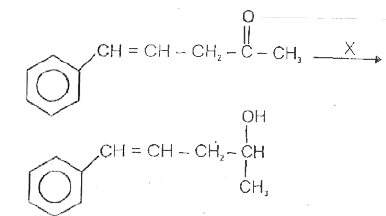Which conversion is an oxidation?
SO_4^2⁻ to SO_3^(2-)
Cu2+→Cu
H+→H
H−→H
The correct Answer is:D
To determine which conversion represents oxidation, we need to analyze the changes in oxidation states for each of the given reactions. Oxidation is defined as an increase in oxidation state.
1. Identify the reactions and their oxidation states:
- Reaction A: SO2−4→SO2−3
- Reaction B: Cu2+→Cu
- Reaction C: H+→H
- Reaction D: H−→H
2. Calculate the oxidation states for each reaction:
- Reaction A:
- For SO2−4: Let the oxidation state of sulfur be x.
x+4(−2)=−2⟹x−8=−2⟹x=+6
- For SO2−3: Let the oxidation state of sulfur be y.
y+3(−2)=−2⟹y−6=−2⟹y=+4
- Change in oxidation state: +6 to +4 (decrease, reduction).
- Reaction B:
- For Cu2+: Oxidation state is +2.
- For Cu: Oxidation state is 0.
- Change in oxidation state: +2 to 0 (decrease, reduction).
- Reaction C:
- For H+: Oxidation state is +1.
- For H: Oxidation state is 0.
- Change in oxidation state: +1 to 0 (decrease, reduction).
- Reaction D:
- For H−: Oxidation state is −1.
- For H: Oxidation state is 0.
- Change in oxidation state: −1 to 0 (increase, oxidation).
3. Determine which reaction is oxidation:
- From the analysis, only Reaction D shows an increase in oxidation state from −1 to 0, which indicates oxidation.
Final Answer:
The conversion that is an oxidation is Reaction D: H−→H.
---
- Reaction A: SO2−4→SO2−3
- Reaction B: Cu2+→Cu
- Reaction C: H+→H
- Reaction D: H−→H
- Reaction A:
- For SO2−4: Let the oxidation state of sulfur be x.
x+4(−2)=−2⟹x−8=−2⟹x=+6
- For SO2−3: Let the oxidation state of sulfur be y.
y+3(−2)=−2⟹y−6=−2⟹y=+4
- Change in oxidation state: +6 to +4 (decrease, reduction).
- For Cu2+: Oxidation state is +2.
- For Cu: Oxidation state is 0.
- Change in oxidation state: +2 to 0 (decrease, reduction).
- For H+: Oxidation state is +1.
- For H: Oxidation state is 0.
- Change in oxidation state: +1 to 0 (decrease, reduction).
- For H−: Oxidation state is −1.
- For H: Oxidation state is 0.
- Change in oxidation state: −1 to 0 (increase, oxidation).
- From the analysis, only Reaction D shows an increase in oxidation state from −1 to 0, which indicates oxidation.
The conversion that is an oxidation is Reaction D: H−→H.
Topper's Solved these Questions
- BOOK - VMC MODULES ENGLISHCHAPTER - STOICHIOMETRY-IIEXERCISE - LEVEL (2)65videos
STOICHIOMETRY-II
- BOOK - VMC MODULES ENGLISHCHAPTER - STOICHIOMETRY-IIEXERCISE - JEE Main (Archive)21videos
STOICHIOMETRY-II
- BOOK - VMC MODULES ENGLISHCHAPTER - STOICHIOMETRY-IIEXERCISE - JEE Advanced (Archive)43videos
STOICHIOMETRY-II
- BOOK - VMC MODULES ENGLISHCHAPTER - STOICHIOMETRY - IEXERCISE - JEE Advanced (Archive)31videos
STOICHIOMETRY - I
- BOOK - VMC MODULES ENGLISHCHAPTER - STRUCTURE OF ATOMEXERCISE - IN-CHAPTER EXERCISE-F7videos
STRUCTURE OF ATOM
Similar Questions
Knowledge Check
- Question 1 - Select One
Assertion : Conversion of potassium ferrocyanide to potassium ferricyanide is an oxidation process.
Reason : Oxidation is the addition of oxygen/electronegative element to a substance or removal of hydrogen/electropositive element from a substance.AIf both assertion and reason are true and reason is the correct explanation of assertion.BIf both assertion and reason are true but reason is not the correct explanation of assertion.CIf assertion is true but reason is false.DIf both assertion and reason are false. - Question 2 - Select One
Which of the following conversions is incorrect?
A1 curie =3.7×1010g−1B1 barn =10−25m2C1 quintal =100kgD1 litre =10−3m3
State whether the following conversions are oxidation or reduction reactions.
PbO2+SO2→PbSO4View SolutionState whether the following conversions are oxidation or reduction reactions.
2C1−−2e−→CI2View SolutionState whether the following conversions are oxidation or reduction reactions.
Cu2++2e−→CuView Solution"Conversion of ethanol of ethanoic acid is an oxidation reaction . " Justify this statement giving the relevant equation for the chemical reaction involved .
View SolutionIn the conversion of

X isView SolutionWhich of the following is correct for phytochrome conversion reaction
View Solution

